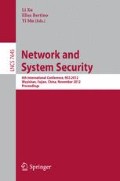Abstract
A novel electronic voting scheme is proposed which is quite suitable for small scale election settings. An outstanding characteristic of the design is its guarantee of unconditionally perfect ballot secrecy. It satisfies self-tallying, fairness and verifiability. Disruption of the result of an election equals to breaking the Discrete Logarithm Problem. Our scheme is built on top of the DC-net(dining cryptographers network) anonymous broadcast protocol. It needs no trusted authority to guarantee its security, but assumes a complete network of secure private channels between voters.
This work was supported by National Natural Science Foundation of China under grant 61101142 and the Fundamental Research Funds for the Central Universities under grant K50510030012.
Access this chapter
Tax calculation will be finalised at checkout
Purchases are for personal use only
Preview
Unable to display preview. Download preview PDF.
References
Kiayias, A., Yung, M.: Self-tallying Elections and Perfect Ballot Secrecy. In: Naccache, D., Paillier, P. (eds.) PKC 2002. LNCS, vol. 2274, pp. 141–158. Springer, Heidelberg (2002)
Damgard, I., Jurik, M.: A Length-flexible Threshold Cryptosystem with Applications. In: Safavi-Naini, R., Seberry, J. (eds.) ACISP 2003. LNCS, vol. 2727, Springer, Heidelberg (2003)
Groth, J.: Efficient Maximal Privacy in Boardroom Voting and Anonymous Broadcast. In: Juels, A. (ed.) FC 2004. LNCS, vol. 3110, pp. 90–104. Springer, Heidelberg (2004)
Hao, F., Ryan, P., Zielinski, P.: Anonymous Voting by 2-Round Public Discussion. IET Information Security 4(2), 62–67 (2010)
Chaum, D.: The Dining Cryptographers Problem: Unconditional Sender and Recipient Untraceability. Journal of Cryptography 1(1), 65–75 (1988)
Cramer, R., Franklin, M.K., Schoenmakers, B., Yung, M.: Multi-authority Secret-Ballot Elections with Linear Work. In: Maurer, U.M. (ed.) EUROCRYPT 1996. LNCS, vol. 1070, pp. 72–83. Springer, Heidelberg (1996)
Cramer, R., Gennaro, R., Schoenmakers, B.: A Secure and Optimally Efficient Multi-authority Election Scheme. In: Fumy, W. (ed.) EUROCRYPT 1997. LNCS, vol. 1233, pp. 103–118. Springer, Heidelberg (1997)
Chaum, D.: Untraceable Electronic Mail, Return Addresses, and Digital Pseudonyms. Communications of the ACM 24(2), 84–88 (1981)
Fujioka, A., Okamoto, T., Ohta, K.: A Practical Secret Voting Scheme for Large Scale Elections. In: Zheng, Y., Seberry, J. (eds.) AUSCRYPT 1992. LNCS, vol. 718, pp. 244–251. Springer, Heidelberg (1993)
Neff, A.: A Verifiable Secret Shuffle and its Application to E-Voting. In: Proceedings of ACM CCS 2001, pp. 116–125. ACM Press, New York (2001)
Okamoto, T.: An Electronic Voting Scheme. In: Proceedings of IFIP 1996, Advanced IT Tools (1996)
Ohkubo, M., Miura, F., Abe, M., Fujioka, A., Okamoto, T.: An Improvement on a Practical Secret Voting Scheme. In: Zheng, Y., Mambo, M. (eds.) ISW 1999. LNCS, vol. 1729, pp. 225–234. Springer, Heidelberg (1999)
Chaum, D.: Elections with Unconditionally-Secret Ballots and Disruption Equivalent to Breaking RSA. In: Günther, C.G. (ed.) EUROCRYPT 1988. LNCS, vol. 330, pp. 177–182. Springer, Heidelberg (1988)
Pfitzmann, B., Waidner, M.: Unconditionally Untraceable and Fault-tolerant Broadcast and Secret Ballot Election. Hildesheimer informatikberichte, Institut fur Informatik (1992)
Dolev, D., Strong, H.: Authenticated Algorithems for Byzantine Agreement. SIAM Journal on Computing 12(4), 656–666 (1983)
Cachin, C., Kursawe, K., Shoup, V.: Random oracles in Constantinople: Practical Asynchronous Byzantine Agreement using Cryptography. Journal of Cryptology 18(3), 219–246 (2005)
Pedersen, T.P.: Non-interactive and Information-Theoretic Secure Verifiable Secret Sharing. In: Feigenbaum, J. (ed.) CRYPTO 1991. LNCS, vol. 576, pp. 129–140. Springer, Heidelberg (1992)
Cramer, R., Damgård, I., Schoenmakers, B.: Proof of Partial Knowledge and Simplified Design of Witness Hiding Protocols. In: Desmedt, Y.G. (ed.) CRYPTO 1994. LNCS, vol. 839, pp. 174–187. Springer, Heidelberg (1994)
Fiat, A., Shamir, A.: How to Prove Yourself: Practical Solutions to Identification and Signature Problems. In: Odlyzko, A.M. (ed.) CRYPTO 1986. LNCS, vol. 263, pp. 186–194. Springer, Heidelberg (1987)
Bellare, M., Rogaway, P.: Random Oracles are Practical: a Paradigm for Designing Efficient Protocols. In: Proceedings of ACM CCS 1993, pp. 62–73. ACM Press, New York (1993)
Bellare, M., Garay, J.A., Rabin, T.: Fast Batch Verification for Modular Exponentiation and Digital Signatures. In: Nyberg, K. (ed.) EUROCRYPT 1998. LNCS, vol. 1403, pp. 236–250. Springer, Heidelberg (1998)
Author information
Authors and Affiliations
Editor information
Editors and Affiliations
Rights and permissions
Copyright information
© 2012 Springer-Verlag Berlin Heidelberg
About this paper
Cite this paper
Li, LH., Huang, CQ., Fu, SF. (2012). Boardroom Voting Scheme with Unconditionally Secret Ballots Based on DC-Net. In: Xu, L., Bertino, E., Mu, Y. (eds) Network and System Security. NSS 2012. Lecture Notes in Computer Science, vol 7645. Springer, Berlin, Heidelberg. https://doi.org/10.1007/978-3-642-34601-9_17
Download citation
DOI: https://doi.org/10.1007/978-3-642-34601-9_17
Publisher Name: Springer, Berlin, Heidelberg
Print ISBN: 978-3-642-34600-2
Online ISBN: 978-3-642-34601-9
eBook Packages: Computer ScienceComputer Science (R0)

